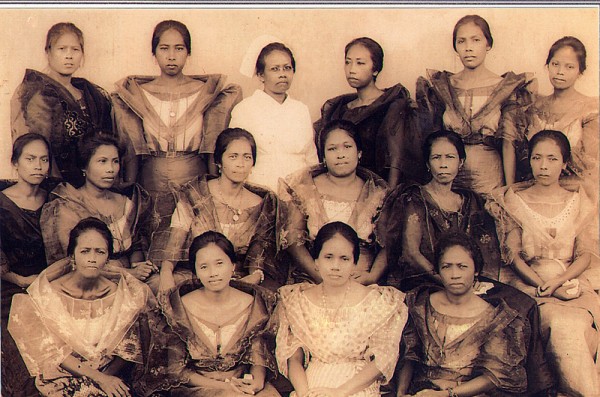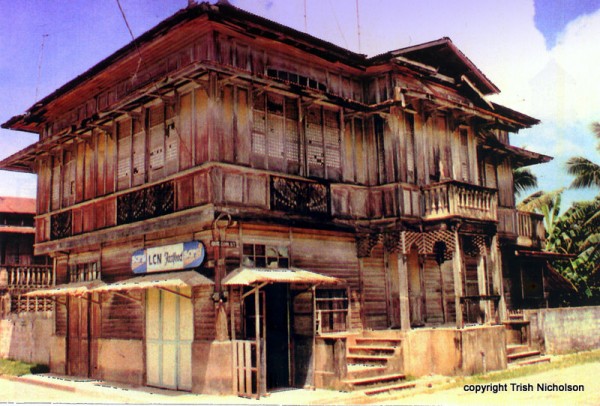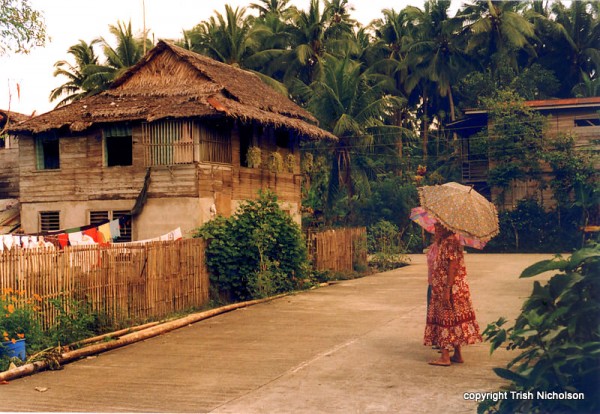 This second tale of Mogpog is about a very important section of society – women. Women can be Moryons, too; masks with feminine features are carved especially for them.
This second tale of Mogpog is about a very important section of society – women. Women can be Moryons, too; masks with feminine features are carved especially for them.
“Society Ladies of Mogpog”
Living in Mogpog, working on my research, I met many wonderful, generous people, especially older Mogpogueños with fascinating memories of the past. Chief among them were my hosts, who asked me to address them as Ate, and Tatay – Tagalog for ‘elder sister’, and ‘father’, respectively. They were, and still are, ‘my Mogpog family’.
One of the people they introduced me to was Leonida, the gracious elderly lady who gave me a copy of this photograph of Mogpog’s influential ladies taken around 1920. Some of their expressions are uncharacteristically grave because photography was a serious and expensive business; they would have been told to ‘keep still’ for the camera.

Such is the cultural continuity in this most traditional of towns that more than 70 years after this photograph of an earlier generation was taken, Leonida knew all their names. How many of us could name the sepia ghosts haunting the pages of our old family albums – if we still have them? I won’t list them fully because their descendents may not want that, but they include Christian names like Marciana, Teofila, Epifania, Eusebia, Alejandra, Concordia and Expectacia – names with the poetic resonance of a bygone era.
It amazes me that in a sticky tropical climate and at a time when laundry was by hand, when there was no electricity, transport was mostly by carabao (buffalo) cart, and wrinkle-free fabrics were not yet invented, these ladies were so impeccably ‘turned out’.
For everyday wear, clothes were made of a local cloth called sinamay (woven from abaca, banana leaf fibre) but for these heavily starched formal dresses, well-off families would acquire silks, brocades and fancy trimmings from China. Chinese traders have plied the coasts and islands of the Philippines for the last 2000 years.
The traditional dress of Filipinas – the baro’t saya – is a full skirt and loose-fitting long-sleeved blouse. These ladies are wearing the formal, and matching, version of this known as the maria clara: named after the main character in the classic Philippine novel, Noli Me Tangere, written in 1890 by Dr Jose Rizal. Rizal became a national hero for his role in the revolution against colonial rule; he was executed by Spanish authorities in 1896. Today, the maria clara has morphed into the terno: made of anything from simple silk to gem-encrusted brocade, it remains an icon of Filipina femininity, worn, for example, by Imelda Marcos – the lady with the shoes.
The ‘elite ladies’ in our photograph may have lived in houses as grand as this must once have been – a judge used to live here – or in something more modest,

but they were pillars of society, members of lay religious groups, caring for the santo figures in the church, organising social and religious events, singing and playing music, giving hospitality – and no doubt roundly scolding the young and lesser relatives who carried out the household chores.
The role of women in Mogpog still centres on Church, family and community. During Moryonan, the two-hundred or so masked and costumed Moryons who roam the town and perform rituals in the church throughout Mahal na Araw (Easter Week), are provided with lunch and merienda (snacks) each day, prepared and cooked by local households.
But however much there is to be done in Mogpog, there is always time to exchange a little tsismis with a neighbour –

[This is an archived post originally posted in 2011 and based on field research carried out during 1995-7. Doubtless some things have changed in Mogpog, but they still celebrate traditional Moryonan, and it is good to record and remember the recent past for future generations.]
Rituals, enactments, street theatre – they are all part of Story’s rich repertoire, along with myths, fables, epics, sagas, legends, folktales and novels, a heritage that has sustained us physically, spiritually and socially since our ancestors were hunters and gatherers. Learn more in this global social history of storytelling: A Biography of Story, A Brief History of Humanity.
If you missed the other Tales in this series, the links are below:
Travel Tales of Mogpog 1: The Town Band
Travel Tales of Mogpog 3: Behind the Mask
Travel Tales of Mogpog 4: More on Masks

Lovely Trisha, thank you. So interesting and the photograph of Mogpog’s influential ladies is fascinating. I wonder what was the story behind the ‘nurse’ type lady in the middle of the back row? What a wonderful experience it must have been to have lived there for a while!
Another wonderful post, Trish. I love hearing the social history of these people. It’s fascinating. Thank you for sharing your research. I do love the pic of the ladies too!
Hi Sue, and Jane, thank you both for reading and commenting, it gives me such pleasure to know others find all this fascinating too. It is especially poignant to celebrate Philippine social history at this time, when so many have lost their loved-ones in the floods that have ravaged southern Philippines. And so hard for friends and family so far away in other countries. Especially hard when much of the world is celebrating a holiday season.
Wow, what a tale. Every time I read you blog posts I notice the great writing and the detailed knowledge and descriptions of the smallest yet the important facts you picked up from life. The pictures are fantastic. So interesting to see different types of costumes and hair styles. Unlike some cultures the ladies in the photo showing their chest and neck area. It’d be interesting to find out why that is. I find it fascinating that different countries have different animals or objects to describe beautiful women. In Mongolia they say ‘As beautiful as a doe'(female deer.) Thank you for sharing your interesting tales with us.
Thank you Guuye, you make some fascinating observations. In Europe, too, we often use the doe, especially the gentle eyes, ‘doe eyes’, to describe women – usually in historical or outdated romance. Fashions for writing change, of course, nowadays people want heroines with more spunk! Often, too, women’s fashions in colonised countries have developed out of missionaries’ ‘horror’ of bare flesh, especially as they were most active in the 19th century when an exposed European ankle was considered provocative, verging on the pornographic. Culture+fashion is an intriguing study I would like time to indulge in one day. I hope you will include something about it in the Mongolia book you are writing.
Trisha, Truly engaging and beautifully told. You had asked what I remembered.I remember being fascinated.I found the masks and everything haunting and deeply evocative.Mesmerizing. I was also deeply involved in women’s studies .The societal and cultural role of the women drew me in. Everything was coloured by my emotional journey at the time which was all about my mother’s illness and imminent death. Although, my education was always focused on Literature and writing,I had great Anthropology and Sociology classes for a few years.I took the trip with an older student who wanted to write a paper on it.I was obsessed at the time with Mexico,The Day of the Dead and certain tribes in the former Dahomey and Kenya. I am loving reading your work on this.Aside from writing,I have owned a company which places physicians in new positions.In the process, I have picked up some Tagalog as I am fairly adept with dialects and languages.Through my work, I have seen the effects and ravages of prior storm there also. Terrible .It has made it that much more difficult to send doctors there. The segment of adventurous physician types who may want to work there does not often want to live in a physically damaged landscape.That leaves only the more selfless candidates.I apologize for rambling .Thank you very much for sharing your excellent,compelling work.I look forward to reading more .
Thank you so much, Patricia, for taking the trouble to share your memories of the Moryonan. Everyone’s experience has unique elements because we can only see things from what is inside us. The amazing thing is, because Filipinos naturally spend Easter with their own families in their local town, few realise how differently it is celebrated even in the next town along the road. One reason for wriitng Masks of the Moryons was to share it for local people. I’ve heard recently from my ‘Mogpog family’ and they are delighted that their cultural traditions are being shared in a respectful way. As to the Mexican connection: Spanish colonial influence in both Mexico and the Philippines does, I think, show-up in ‘Spanish features’ of some of the masks made in both countries, but deep delving during the original research revealed no more direct link than that. Thank you again, and I enjoyed your ‘rambling’ – how about starting your own blog, I’d love to read more of your experience 🙂
Thank you.No,I know.I did not believe there was any substantive link to Mexico.It was just a Soc/Anthro aside .I am starting a blog in the next few weeks.OR I think I am.I registered it a long time ago and simply never started. I thought it would take time from my writing or other writing projects. I only started twitter 5 wks ago. Now that I decided to stay,I will put up some picture,get rid of the egg and start blogging. I look forward to reading more.
I will look forward to your new blog. Please tweet me when your first post is up so that I don’t miss it 🙂
I find your writing fascinating Trish.I came on here to look at your treehouse but have become so interested in your stories about the Philippines that I’m going to read them again because there’s so much information.
Your tree house is such a brilliant idea and what a view,I can just imagine sitting watching the sun go down with a glass of wine. The only time I have been in a tree house was in Turkey at a trout farm, the had treehouse where you could have lunch of fresh trout while looking out onto the the river,it was bliss and we hope to go back again this year. I envy youhaving one all of your own.
So glad you enjoyed your visit, and thank you for your kind words. One of the benefits of the treehouse, apart from the view and the cool summer. is that there is no internet connection. As much as I enjoy social media, it is good to have a place away from it. The treehouse in Turkey sounds fun. In Europe, restaurants in treehouses became all the rage after Daniel Defoe’s ‘Swiss Family Robinson’ was published. You’ve inspired me: when I have time, I’ll write a blog post on some of the connections between treehouses and writers 🙂